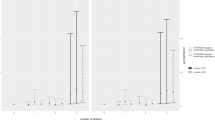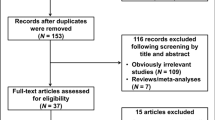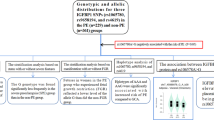Abstract
Associations have been reported between estrogen receptor α (ESR1) gene polymorphisms and various pathological conditions, including cardiovascular diseases. Our aim was to investigate whether two polymorphisms of the ESR1 gene (ESR1 c.454 −397T>C: PvuII restriction site and c.454 −351A>G: XbaI restriction site) are associated with preeclampsia. In a case-control study, we analyzed blood samples from 119 severely preeclamptic patients and 103 normotensive, healthy pregnant women using the polymerase chain reaction (PCR)−restriction fragment length polymorphism (RFLP) method. All of the women were Caucasian. There was no association between severe preeclampsia and the PvuII and XbaI ESR1 gene polymorphisms separately. However, with the simultaneous carriage of both polymorphisms, the TT/AA genotype combination was significantly more frequent in severely preeclamptic patients than in healthy control subjects (24.4% vs. 9.7%, p=0.003), whereas the TT/AG combination was significantly less frequent in the severely preeclamptic group than in the control group (5.0% vs. 18.4%, p=0.002). According to the haplotype estimation, the homozygous T-A haplotype carriers had an increased risk of severe preeclampsia independent of maternal age, prepregnancy BMI, primiparity and smoking status (adjusted odds ratio [OR]: 4.36, 95% confidence interval [CI]: 1.65–11.53). The GG genotype of the XbaI polymorphism was associated with a lower risk of fetal growth restriction in patients with severe preeclampsia (OR: 0.23, 95% CI: 0.07–0.73). In conclusion, the homozygous T-A haplotype carriers of ESR1 PvuII and XbaI polymorphisms showed an increased risk of severe preeclampsia. In addition, the GG genotype of the XbaI polymorphism decreased the risk of fetal growth restriction in severely preeclamptic patients.
Similar content being viewed by others
Article PDF
References
Parker MG, Arbuckle N, Dauvois S, Danielian P, White R : Structure and function of the estrogen receptor. Ann N Y Acad Sci 1993; 684: 119–126.
Mendelsohn ME, Karas RH : The protective effects of estrogen on the cardiovascular system. N Engl J Med 1999; 340: 1801–1811.
Li L, Haynes MP, Bender JR : Plasma membrane localization and function of the estrogen receptor alpha variant (ER46) in human endothelial cells. Proc Natl Acad Sci U S A 2003; 100: 4807–4812.
Kuiper GG, Carlsson B, Grandien K, et al: Comparison of the ligand binding specificity and transcript tissue distribution of estrogen receptors alpha and beta. Endocrinology 1997; 138: 863–870.
Pelletier G, El Alfy M : Immunocytochemical localization of estrogen receptors alpha and beta in the human reproductive organs. J Clin Endocrinol Metab 2000; 85: 4835–4840.
Ponglikitmongkol M, Green S, Chambon P : Genomic organization of the human oestrogen receptor gene. EMBO J 1988; 7: 3385–3388.
Lehrer S, Rabin J, Kalir T, Schachter BS : Estrogen receptor variant and hypertension in women. Hypertension 1993; 21: 439–441.
Shearman AM, Cupples LA, Demissie S, et al: Association between estrogen receptor alpha gene variation and cardiovascular disease. JAMA 2003; 290: 2263–2270.
Schuit SC, Oei HH, Witteman JC, et al: Estrogen receptor alpha gene polymorphisms and risk of myocardial infarction. JAMA 2004; 291: 2969–2977.
Shearman AM, Cooper JA, Kotwinski PJ, et al: Estrogen receptor alpha gene variation and the risk of stroke. Stroke 2005; 36: 2281–2282.
Ellis JA, Infantino T, Harrap SB : Sex-dependent association of blood pressure with oestrogen receptor genes ERalpha and ERbeta. J Hypertens 2004; 22: 1127–1131.
Peter I, Shearman AM, Zucker DR, et al: Variation in estrogen-related genes and cross-sectional and longitudinal blood pressure in the Framingham Heart Study. J Hypertens 2005; 23: 2193–2200.
Ohkuchi A, Iwasaki R, Suzuki H, et al: Normal and high-normal blood pressures, but not body mass index, are risk factors for the subsequent occurrence of both preeclampsia and gestational hypertension: a retrospective cohort study. Hypertens Res 2006; 29: 161–167.
Hirashima C, Ohkuchi A, Arai F, et al: Establishing reference values for both total soluble fms-like tyrosine kinase 1 and free placental growth factor in pregnant women. Hypertens Res 2005; 28: 727–732.
Yum MK, Kim K, Kim JH, Park EY : A consistent abnormality in the average local smoothness of fetal heart rate in growth-restricted fetuses affected by severe pre-eclampsia. Hypertens Res 2004; 27: 911–918.
Ness RB, Markovic N, Bass D, Harger G, Roberts JM : Family history of hypertension, heart disease, and stroke among women who develop hypertension in pregnancy. Obstet Gynecol 2003; 102: 1366–1371.
Rigo J Jr, Boze T, Derzsy Z, et al: Family history of early-onset cardiovascular disorders is associated with a higher risk of severe preeclampsia. Eur J Obstet Gynecol Reprod Biol 2006; 128: 148–151.
Roberts JM, Gammill H : Pre-eclampsia and cardiovascular disease in later life. Lancet 2005; 366: 961–962.
National High Blood Pressure Education Program Working Group on High Blood Pressure in Pregnancy: Report of the National High Blood Pressure Education Program Working Group on High Blood Pressure in Pregnancy. Am J Obstet Gynecol 2000; 183: S1–S22.
ACOG Committee on Practice Bulletins—Obstetrics : ACOG practice bulletin. Diagnosis and management of preeclampsia and eclampsia. Number 33, January 2002. Obstet Gynecol 2002; 99: 159–167.
Joubert K : Standards of the body mass and body length of birth in Hungary on the basis of the 1990–1996 nation-wide liveborn data. Magy Noorv L 2000; 63: 155–163.
Malamitsi-Puchner A, Tziotis J, Evangelopoulos D, et al: Gene analysis of the N-terminal region of the estrogen receptor alpha in preeclampsia. Steroids 2001; 66: 695–700.
Tempfer CB, Jirecek S, Riener EK, et al: Polymorphisms of thrombophilic and vasoactive genes and severe preeclampsia: a pilot study. J Soc Gynecol Investig 2004; 11: 227–231.
Maruyama A, Nakayama T, Sato N, Mizutani Y, Furuya K, Yamamoto T : Association study using single nucleotide polymorphisms in the estrogen receptor beta (ESR2) gene for preeclampsia. Hypertens Res 2004; 27: 903–909.
Scohy S, Gabant P, Szpirer C, Szpirer J : Identification of an enhancer and an alternative promoter in the first intron of the alpha-fetoprotein gene. Nucleic Acids Res 2000; 28: 3743–3751.
Gotoda T, Kinoshita M, Ishibashi S, et al: Skipping of exon 14 and possible instability of both the mRNA and the resultant truncated protein underlie a common cholesteryl ester transfer protein deficiency in Japan. Arterioscler Thromb Vasc Biol 1997; 17: 1376–1381.
O'Neill JP, Rogan PK, Cariello N, Nicklas JA : Mutations that alter RNA splicing of the human HPRT gene: a review of the spectrum. Mutat Res 1998; 411: 179–214.
Herrington DM, Howard TD, Brosnihan KB, et al: Common estrogen receptor polymorphism augments effects of hormone replacement therapy on E-selectin but not C-reactive protein. Circulation 2002; 105: 1879–1882.
Swartz CD, Afshari CA, Yu L, Hall KE, Dixon D : Estrogen-induced changes in IGF-I, Myb family and MAP kinase pathway genes in human uterine leiomyoma and normal uterine smooth muscle cell lines. Mol Hum Reprod 2005; 11: 441–450.
Brouchet L, Krust A, Dupont S, Chambon P, Bayard F, Arnal JF : Estradiol accelerates reendothelialization in mouse carotid artery through estrogen receptor-alpha but not estrogen receptor-beta. Circulation 2001; 103: 423–428.
Pare G, Krust A, Karas RH, et al: Estrogen receptor-alpha mediates the protective effects of estrogen against vascular injury. Circ Res 2002; 90: 1087–1092.
Karas RH, Schulten H, Pare G, et al: Effects of estrogen on the vascular injury response in estrogen receptor alpha, beta (double) knockout mice. Circ Res 2001; 89: 534–539.
Byers MJ, Zangl A, Phernetton TM, Lopez G, Chen DB, Magness RR : Endothelial vasodilator production by ovine uterine and systemic arteries: ovarian steroid and pregnancy control of ERalpha and ERbeta levels. J Physiol 2005; 565: 85–99.
Lehrer S, Sanchez M, Song HK, et al: Oestrogen receptor B-region polymorphism and spontaneous abortion in women with breast cancer. Lancet 1990; 335: 622–624.
Derzbach L, Treszl A, Balogh A, Vasarhelyi B, Tulassay T, Rigo J Jr : Gender dependent association between perinatal morbidity and estrogen receptor-alpha PvuII polymorphism. J Perinat Med 2005; 33: 461–462.
Sharkey LC, McCune SA, Yuan O, Lange C, Fray J : Spontaneous pregnancy-induced hypertension and intrauterine growth restriction in rats. Am J Hypertens 2001; 14: 1058–1066.
Forman MR, Cantwell MM, Ronckers C, Zhang Y : Through the looking glass at early-life exposures and breast cancer risk. Cancer Invest 2005; 23: 609–624.
Roberts JM, Pearson GD, Cutler JA, Lindheimer MD : Summary of the NHLBI Working Group on Research on Hypertension during Pregnancy. Hypertens Pregnancy 2003; 22: 109–127.
Author information
Authors and Affiliations
Corresponding author
Rights and permissions
About this article
Cite this article
Molvarec, A., Vér, Á., Fekete, A. et al. Association between Estrogen Receptor α (ESR1) Gene Polymorphisms and Severe Preeclampsia. Hypertens Res 30, 205–211 (2007). https://doi.org/10.1291/hypres.30.205
Received:
Accepted:
Issue Date:
DOI: https://doi.org/10.1291/hypres.30.205
Keywords
This article is cited by
-
Genetic variations in estrogen and progesterone pathway genes in preeclampsia patients and controls in Bavaria
Archives of Gynecology and Obstetrics (2021)
-
Association of ESR1 (rs2234693 and rs9340799), CETP (rs708272), MTHFR (rs1801133 and rs2274976) and MS (rs185087) polymorphisms with Coronary Artery Disease (CAD)
BMC Cardiovascular Disorders (2020)
-
Androgen and estrogen receptors in placental physiology and dysfunction
Frontiers in Biology (2018)
-
Polymorphisms of the IL27 gene in a Chinese Han population complicated with pre-eclampsia
Scientific Reports (2016)
-
Association between estrogen receptora gene (ESR1) PvuII (T/C) and XbaI (A/G) polymorphisms and premature ovarian failure risk: evidence from a meta-analysis
Journal of Assisted Reproduction and Genetics (2015)



